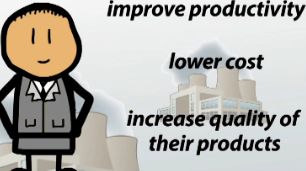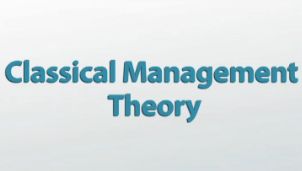Classical Management Theory (1900-1930): Definition - Quiz
Choose your answer and write the correct one down. Then click HERE for the answers to this quiz.
NOTE: The transcript from the video is listed below the quiz for your reference.
1. Classical Management approaches can be seen in contemporary organizations
- Administrative Management
- Scientific Management
- Republic Management
- Bureaucratic Management
2. Classical Management approaches can be seen in contemporary organizations
- True
- False
3. Which of the following statement does not represent Classical Management theory
- Managers are concerned with increasing employee efficiency through training.
- Managers do not care to manage employee/manager relationships.
- Managers are concerned with decreasing costs.
- Managers are concerned with increasing productivity in workers.
4. Classical Management theory is concerned with
- Using the 'it depends' approach
- Finding the best possible way to perform and manage a task
- Decreasing cost and efficiency
- Increasing productivity and cost
5. The Classical Management approach emerged during what time period?
- The Factory Revolution
- The Industrial Revolution
- The Technological Revolution
- The Productive Revolution
It was the rise of the Industrial Revolution and factories were becoming more common. Inside these factories, managers were constantly look for ways to improve productivity and efficiency. As time moved on, it became apparent that searching for the single best way to do things was the most important thing for managers to do. Thus, classical management theory was born. This lesson will discuss the evolution of classical management theory.
The Evolution of Classical Management Theory
The Industrial Revolution was a time where innovation really began to change the way that products were produced and sold. The invention of machines to produce goods in the 19th century drastically improved productivity, which in turn lowered the cost to the consumer. The lower price resulted in a greater demand for products and thus a greater need for more factories and workers.
 |
As factories increased in number, managers continued to search for ways to improve productivity, lower cost, increase quality of their products, improve employee/manager relationships and increase efficiency. The focus shifted from using machines to increase productivity to how they could increase employee productivity and efficiency. When they did this, they began to notice some new problems inside their factory systems. Employees were dissatisfied with their current working conditions, and many lacked the necessary training for how to do their work efficiently. Managers then began to formulate and test possible solutions, one of which was to find the best possible way for workers to perform and manage their tasks. The research resulted in the development of classical management theory.
The Classical Manager
To better understand classical management theory, let's take a peek into this 19th century factory and see what's going on. Ahh, there he is: Calvin the Classical Manager. Let's look a bit closer and see what he's up to. It looks like Calvin is working on a work-flow chart. It seems he's trying to figure out the best possible way to complete work at his factory.
As a classical manager, Calvin must have a good understanding of business functions at his factory so that he can structure the organization according to task and assign workers in view of that. For example, I can see that Calvin has broken down the process for producing the product this factory makes into three stages. In each stage, he has listed out what work needs to be completed and the type of skills a worker will need to complete that work. Now all Calvin has left to do is assess his current workforce for the appropriate individuals and place them in the suitable job role. If training is needed, Calvin will need to identify that so that he can ensure his workers understand the manner in which the work should be completed.
 |
Expansion of Classical Management Theory
Classical Management theory expanded throughout the first half of the 20th century as managers continued to look for ways to deal with issues surrounding industrial management. During this time, three separate branches emerged - bureaucratic management, classical scientific management and classical administrative management - each unique in its approach towards finding the best possible way. These three branches will be explained in more detail in the following lessons. Even though several management theories have emerged since the development of classical management theory, many contemporary organizations rely on the classical management approach today with great success.
 |
Lesson Review
Let's review. Classical management theory was introduced in the late 19th century during the Industrial Revolution. At the time, managers were interested in findings ways to improve productivity, lower cost, increase quality of their products, improve employee/manager relationships and increase efficiency at their factories. The main concern for classical management theorists is finding the best possible way for workers to perform and manage their tasks. Classical management theory is comprised of three separate branches - bureaucratic management, classical scientific management and classical administrative management - each unique in its approach towards finding the best possible way. Many of today's organizations continue to rely on the classical management approach.